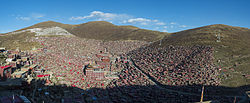Shambala | |
|---|---|
| Tibetan transcription(s) | |
| • Tibetan | ཤམ་བྷ་ལ་གྲོང་རྡལ། |
| • Wylie transliteration | sham bha la grong rdal |
| Chinese transcription(s) | |
| • Simplified | 香巴拉镇 |
| • Traditional | 香巴拉鎮 |
| • Pinyin | Xiāngbālā Zhèn |
| Coordinates: 28°55′51″N99°48′03″E / 28.93083°N 99.80083°E | |
| Country | China |
| Province | Sichuan |
| Prefecture | Garzê |
| County | Xiangcheng |
| Elevation | 2,888 m (9,475 ft) |
| Time zone | UTC+8 (China Standard) |
| Postal code | 513336100 |
| Area code | 0836 |
Shambala (Tibetan : ཤམ་བྷ་ལ, Wylie : sham bha la; Chinese :香巴拉; pinyin :Xiāngbālā) is a town and the seat of Xiangcheng County, [1] southwestern Garzê Tibetan Autonomous Prefecture, western Sichuan province of southwest China. Before 2005, it was called Samphel (Tibetan : བསམ་འཕེལ, Wylie : bsam 'phel, Chinese :桑披; pinyin :Sāngpī).


